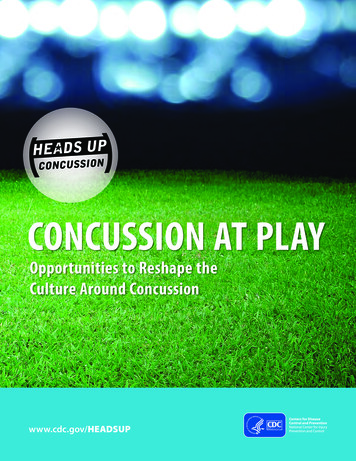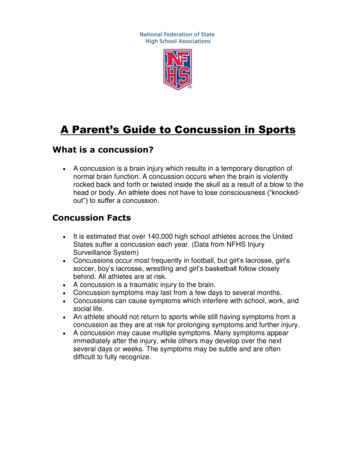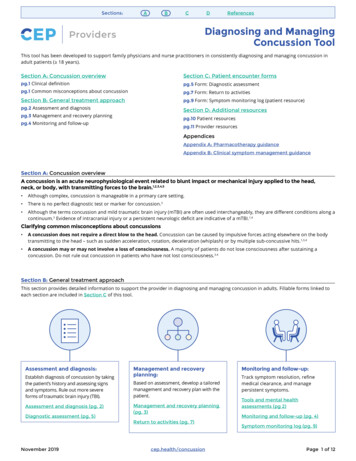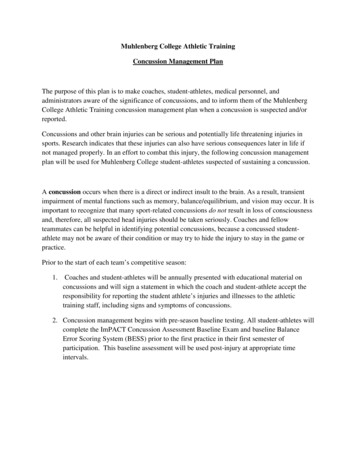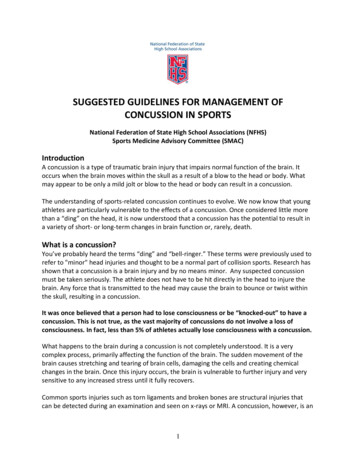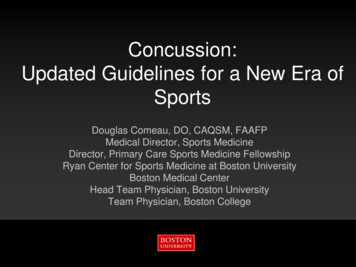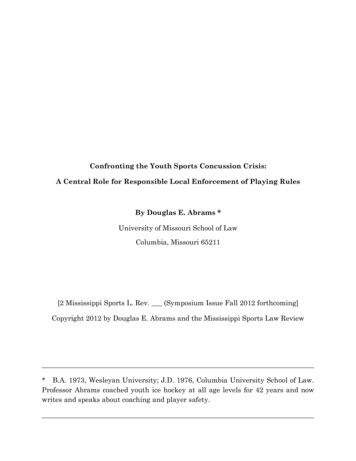
Transcription
Confronting the Youth Sports Concussion Crisis:A Central Role for Responsible Local Enforcement of Playing RulesBy Douglas E. Abrams *University of Missouri School of LawColumbia, Missouri 65211[2 Mississippi Sports L. Rev. (Symposium Issue Fall 2012 forthcoming]Copyright 2012 by Douglas E. Abrams and the Mississippi Sports Law Review* B.A. 1973, Wesleyan University; J.D. 1976, Columbia University School of Law.Professor Abrams coached youth ice hockey at all age levels for 42 years and nowwrites and speaks about coaching and player safety.
TABLE OF CONTENTSI.INTRODUCTIONII.PREVENTING YOUTH SPORTS CONCUSSIONSA.B.1.III.THE LAW’S ROLE IN YOUTH SPORTS SAFETYA.B.IV.The Contemporary Sports Concussion Crisis1.Professional sports2.Youth sportsMeeting the Youth Sports Concussion Crisis1.Ongoing review of national playing rulesa. Pop Warner footballb.USA Hockey2.Implementation of playing rules: “All safety is local”a.Medical researchb.Abuse of game officialsRecent State Concussion LegislationLitigationCONCLUSION
I.INTRODUCTIONBy late 1905, college football was at a crossroads.Raw violence andunremitting bloodshed had stalked the gridiron for years. In that season alone,eighteen players would be killed and scores more would be seriously injured inintercollegiate games.1 As Americans cringed, calls to abolish the sport as barbaricgrew louder because games and death did not mix on college campuses.2The specter of death in college football was serious business at the dawn ofthe 20th century. A national professional league was still a few years away, so thecollegiate game was the most prominent football in America. Even one on-the-fielddeath among several thousand college football players today would attract nationalattention; because far fewer collegians played football in 1905, 18 deaths in a singleseason was an astounding percentage of all players, a grim toll unlikely to abatewithout meaningful changes to the rules of the game.Most of the deaths were from what would be diagnosed today as multipleconcussions, skull fractures, or other traumatic brain injury.3 At the turn of thecentury, some intercollegiate football players wore skimpy protective equipmentand soft leather helmets without face guards, but helmets did not becomeMARK F. BERNSTEIN, FOOTBALL: THE IVY LEAGUE ORIGINS OF AN AMERICANOBSESSION 80 (2001).2LINDA CARROLL & DAVID ROSNER, THE CONCUSSION CRISIS: ANATOMY OF ASILENT EPIDEMIC 50 (2011).3Id.1
mandatory in National Collegiate Athletic Association (NCAA) play until 1939.4Game photos from the period show that most players went helmetless,5 even thoughcollege football had degenerated into “a game of mass interference which leveled thedefense. Line play deteriorated to brute force where linemen slugged one anotherand the ball carrier was pulled and pushed into this mass of humanity.”6Some colleges, notably Columbia and Northwestern, reacted to the carnageby eliminating their football programs altogether.7 Disgusted by the unrelentingbloodshed, President Theodore Roosevelt grew worried that more colleges wouldfollow suit (including his alma mater, Harvard).8Roosevelt was a vigorous sportsman who respected athletic competition,indeed one of the most athletic Presidents we have ever had.9He was also a“gridiron enthusiast” who closely followed Harvard’s eleven, which he might havejoined as an undergraduate little more than 25 years earlier but for hisnearsightedness.10 He embraced football for manifesting rugged Americanism justa few years after the U.S. Census Bureau inspired national soul-searching byMichael L. Levy et al., Birth and Evolution of the Football Helmet, 55NEUROSURGERY 656, 656 (2004).5See, e.g., Mark F. Bernstein, supra note 1 (photographs following page 146);IVAN N. KAYE, GOOD CLEAN VIOLENCE: A HISTORY OF COLLEGE FOOTBALL,frontispiece, 54 (1973); JOHN SAYLE WATTERSON, COLLEGE FOOTBALL: HISTORY,SPECTACLE, CONTROVERSY (2000) (photographs following page 98).6TOM PERRIN, FOOTBALL: A COLLEGE HISTORY 53-54 (1987).7John Sayle Watterson, supra note 5, at 73, 92.8Id. at 64.9JOHN SAYLE WATTERSON, THE GAMES PRESIDENTS PLAY 71-72 (2006).10Mark F. Bernstein, supra note 1, at 12; John Sayle Watterson, supra note 5,at 64; EVAN THOMAS, THE WAR LOVERS: ROOSEVELT, LODGE, HEARST, AND THE RUSHTO EMPIRE, 1898, at 56 (2010).4
announcing the closing of the frontier in 1890.11 When he charged San Juan Hillduring the Spanish-American War, his Rough Riders included former collegefootball players who won his respect.12“To borrow a simile from the football field,” Roosevelt said in 1897, “webelieve that men must play fair, but that there must be no shirking, and that thesuccess can only come to the player who ‘hits the line hard.’”13 From the WhiteHouse, he wrote to his son, Theodore, Jr., who played on Harvard’s freshman team:“I am delighted to have you play football. I believe in rough, manly sports.”14In October of 1905, with “football staring hard at the prospect of demise,”15President Roosevelt summoned the head coach and alumni committee head fromeach of the “Big Three” collegiate gridiron powers -- Harvard, Yale and Princeton -to convene at the White House and explore ways to maintain the game’sdistinctiveness as a collision sport, yet stem its unrestrained brutality.16Barely a month before the college football delegations arrived, Roosevelt hadmediated an end to the Russo-Japanese War, an effort that earned him the NobelMark F. Bernstein, supra note 1, at 38; John Sayle Watterson, supra note 5,at 65; Evan Thomas, supra note 10, at 55-57; FREDERICK JACKSON TURNER, THEFRONTIER IN AMERICAN HISTORY 1-38 nda Carroll & David Rosner, supra note 2, at 50; see also John SayleWatterson, supra note 5, at 64-65 (quoting Roosevelt’s letter to a friend: “I wouldrather see my boys play [football] than see them play any other” sport).15JOSEPH N. CROWLEY, IN THE ARENA: THE NCAA’S FIRST CENTURY 41 (2006).16Mark F. Bernstein, supra note 1, at 38, 79-83 (2001); Joseph N. Crowley,supra note 15, at 40-43.11
Peace Prize.17 With participants considerably less hostile to one another thanwarring nations, the White House football summit led to safety-based rules changesthat would soon make sudden deaths from play on the field remnants of the past.18The summit also led to creation of the NCAA, the national governing body thatwould oversee enforcement of playing rules by member colleges and universities.19Safety-based rules changes did not doom public enthusiasm for football.Quite the contrary.College and professional football remain the nation’s mostpopular spectator sports today,20 and the highest award the NCAA bestows on anindividual is the Theodore Roosevelt Award, honoring the man whose presidentialinitiative saved the game from itself.21****Without suggesting intervention by Congress or any state legislature,President Roosevelt confronted college football’s brain injury crisis by advocatingnational rules changes that conferences, coaches and referees would administerresponsibly in local games. Injury prevention was central to the President’s formulaHENRY F. PRINGLE, THEODORE ROOSEVELT 185-96 (1956); Edmund Morris,THEODORE REX 131-37, 150-69; THEODORE ROOSEVELT: AN AUTOBIOGRAPHY 555-58(1913).18John Sayle Watterson, supra note 5, at 100-10.19Joseph N. Crowley, supra note 15, at 43-44.20Harris Interactive, Football is America’s Favorite Sport as Lead OverBaseball Continues to Grow: College Football and Auto Racing Come %20Poll%209%20%20Favorite%20sport 1.25.12.pdf (Jan. 25, rs Calebration/Theodore Roosevelt Award.17
because mere reaction to serious injury came too late, only after the player and hisfamily suffered loss that could not be undone.Today the sports world faces a similar crisis from an epidemic22 of seriousand often permanent brain injury. Today’s crisis -- “the predominant youth sportssafety issue of the 21st century”23 -- concerns concussions, a form of traumatic braininjury from externally inflicted trauma.24 “[H]ead trauma in sports is a topic thatleads nightly newscasts and is debated at every level of amateur and professionalsports.”25 Concussions produce “contact sports' nastiest byproducts,” with “longterm effects . . . [that] are proving to be absolutely terrifying.”26Until a few years ago, the national spotlight shined most brightly on concussionssuffered by professional athletes, particularly football and ice hockey players.Asneurosurgeon William P. Meehan reports, however, we know now that “concussion is a riskin almost any sport.”27We also know, as Time reports, that “concussions are anSee, e.g., Linda Carroll & David Rosner, supra note 2.Brooke de Lench, Praise For MomsTEAM Is Nice, But The Fight To MakeYouth Sports Safer Isn't Over, ot-yetover#ixzz22VEOtiR9 (May 23, 2012); see also, e.g., Lyle J. Micheli, Foreword, inWILLIAM PAUL MEEHAN III, KIDS, SPORTS, AND CONCUSSION: A GUIDE FOR COACHESAND PARENTS xi (2011) (“[a] true health crisis”); Alan Schwartz, High School PlayersShrug Off Concussions, Raising Risks, N.Y. TIMES, Sept. 15, 2007, at A1 (quotingRobert Sallis, president of the American College of Sports Medicine; “Poormanagement of high school players' concussions isn't just a football issue. It's amatter of public health.”).24NIH Consensus Dev. Panel on Rehabilitation of Persons With TraumaticBrain Injury, Rehabilitation of Persons With Traumatic Brain Injury 5 (1998).25ROBERT CANTU & MARK HYMAN, CONCUSSIONS AND OUR KIDS 2 (2012).26Alan Siegel, How to Fix Sports’ Concussion Crisis, THE ATLANTIC, Sept. 27,2011.27William Paul Meehan III, supra note 23, at 37; see also Michael W. Kirkwoodet al., Pediatric Sport-Related Concussion: A Review of the Clinical Management of2223
alarmingly commonplace injury, particularly among kids and most particularlyamong active, athletic ones.”28 Whether or not the victim loses consciousness,29 aconcussion at any age “can affect memory, judgment, reflexes, speech, balance, and musclecoordination and can result in serious complications, such as swelling, bruising, or bleedingof the brain, which can cause permanent disability or death.”30Today’s concussion crisis31 summons a range of preventive strategies,including the one President Roosevelt prescribed for college football in 1905 – publiceducation about profound safety risks, ongoing review of national playing rulesbased on new learning, and responsible local implementation of these rules inpractice sessions and games. Mere reaction to a player’s brain injury cannot undoprior damage.This article concerns the effect of playing rules on efforts to confront today’sconcussion crisis in “youth sports.” The term “youth sports” covers the two primarysources of organized athletics for children – community leagues and teamsan Oft-Neglected Population, 117 PEDIATRICS 1359, 1360 (2006) (“Nearly all athleticendeavors pose some risk of concussive /0,28804,2043395 2043506 2043494,00.html (Feb. 3, 2011).29Robert Cantu & Mark Hyman, supra note 25, at 106-07 (95% of victims whosuffer concussions do not lose consciousness); James P. Kelly, Traumatic BrainInjury and Concussion in Sports, 282 J. AM. MED. ASS’N 989, 990 (1999)(“Concussion . . . may or may not involve loss of consciousness”).30U.S. Gov’t Accountability Office, Concussion in High School Sports, GAO-10569T (May 20, 2010) (statement of Linda T. Kohn, Director, Health Care); Brookede Lench, Concussions Double For Younger Athletes In Team Sports, Study study-finds (Sept. 1, 2010) (quoting Dr. Lisa L. Bakhos:“[C]oncussions can happen to anyone. Some [parents] may think, my child is tooyoung to get really hurt in sport, but that is not the case.”).31Linda Carroll & David Rosner, supra note 2.
conducted by parents in private associations or clubs, or by public parks andrecreation departments; and interscholastic leagues conducted by public and privatesecondary schools.I remain awed by the sheer quality and quantity of research and commentarygenerated in recent years by prominent medical professionals seeking to stimulatepublic awareness of sports-related brain injuries in children. Without venturinginto a profession in which I lack training, I seek to apply this learning from myvantage as a lawyer, and as a youth hockey coach concerned for more than 40 yearsabout player safety. For ten of these years, I also served as president of a youthhockey program and thus designed and helped supervise safety measures taken byother volunteer coaches.President Roosevelt sought to save football, and not eradicate it. I recognizethat participation in sports inevitably brings risk of injury at any age, and thatcontact and collision sports depend on a measure of controlled violence within therules of the game. We can significantly reduce the risk of childhood sports-relatedconcussions and other brain trauma, however, by periodically adjusting safetybased playing rules in light of medical learning, and then by assuring theirresponsible enforcement by coaches, league administrators, game officials andparents who remain committed to sportsmanship and mutual respect in vibrantlocal games.
Now that children’s spontaneous sandlot play has yielded to organized youthsports programs conducted by adults,32 injury prevention grounded in fidelity to therules of the game is more than an adult challenge and opportunity. This centralinjury-prevention strategy is an adult responsibility because “every hit to the headleaves a mark, or a legacy, on a child’s future.”33Part II of this article discusses rules-based prevention of concussions andother traumatic brain injury in youth sports, a proactive stance that the NationalInstitutes of Health says holds “great promise.”34 Primary responsibility for therules rests with national youth sports governing bodies (USA Soccer, USA Hockeyand others), and with the state high school activities associations that oversee theinterscholastic sports programs conducted by their member secondary schools.Rulemaking remains a work in progress, but national and state rulemakers haveproved increasingly responsive to parents, medical professionals, legislators andsimilar voices who have advocated periodic review.National and state rulemaking, however, does not end the story becauseyouth games are played from coast to coast on fields and other local venues largelybeyond the direct day-to-day supervision of national and state governing bodies.Part II explains why the rules of the game stand the best chance of protectingDouglas E. Abrams, The Challenge Facing Parents and Coaches in YouthSports: Assuring Children Fun and Equal Opportunity, 8 VILLANOVA SPORTS & ENT.L.J. 253, 264-65 (2002).33Sports Legacy Inst., Our Story, te/about-sli/.34NIH Consensus Dev. Panel, supra note 24, at 9.32
players when coaches, league administrators, game officials and parents enforce therules responsibly.Part II concludes by discussing how local adult irresponsibility, particularlywhen passion to win overcomes reason in the heat of competition, can neutralizenational and state safety-based playing rules and put young athletes in harm’s way.These rules resemble an impressive building, which may take years to design andconstruct with care, but which can be imploded locally in moments.Part III discusses the role of legal constraints in the quest for greater safetyfrom concussions in youth sports. Most states have taken a giant step forward since2009 by enacting concussion legislation that, while not displacing safety-basedreview and enforcement of playing rules, holds potential to make life better for thenation’s youngest athletes who play under those rules.Parents, coaches andplayers generally must receive information and education about the dangers ofconcussions and when to suspect that a player may have suffered one. When aplayer is suspected to have suffered possible concussive injury, teams and coachesmust immediately remove the player from practice sessions and games until theplayer secures medical clearance to return to action.Thus far, however, private litigation has played comparatively little directrole in preventing youth league concussions. The specter of lawsuits by injuredplayers might influence and indeed accelerate safety initiatives by stimulating thesensibilities of rulemakers and other concerned adults, by jeopardizing theavailability of insurance at favorable rates, or by leaving individual parents
reluctant to enroll their children. These prospects seem already to have movednational and state governing bodies toward greater safety measures, but lawsuits inlarge numbers have not yet been reported in youth sports.35Recovery in an injured player’s tort suit against governing bodies, leaguesand coaches can help ease the frequently substantial financial burdens of shortterm and long term care following a concussion or other traumatic brain injury.Recovery, however, comes only after the player has suffered immediate andsometimes permanent damage.In practice sessions and games alike, youthleaguers are best protected from concussions and other serious injury with proactiveprevention, rather than essentially reactive tort law.II.PREVENTING YOUTH SPORTS CONCUSSIONSEmphasizing injury prevention initiatives in youth sports plows no newground because prevention initiatives in the schools and the greater communityalready seek to protect children from an array of potential dangers, such asdelinquency, bullying and school violence.36 Because parents in their own homesalso strive to prevent childhood injuries (including ones from sports and games), itseems natural to contemplate injury prevention initiatives in the organized sportstheir children play in the community.See infra note 53 and accompanying text (discussing class action lawsuit bymore than 2,000 former National Football league players against the NFL arisingout of the concussion crisis).36See, e.g., Douglas E. Abrams, A Coordinated Public Response to SchoolBullying, in OUR PROMISE: ACHIEVING EDUCATIONAL EQUALITY FOR AMERICA’SCHILDREN 399, 410-12 (Maurice R. Dyson & Daniel B. Weddle eds., 2009).35
Prevention initiatives measure success by rates of reduction rather than bytotal elimination of targeted conduct. The nation cannot eliminate all delinquency,bullying, or school violence -- or all youth sports concussions -- but parents andsafety advocates can strive for significant reduction rather than tolerate continuedhigh rates of adverse outcomes controllable through due care.37As BenjaminFranklin said, “an ounce of prevention is worth a pound of cure.”38A.1.The Contemporary Sports Concussion CrisisProfessional sportsWhen parents first enroll a child in a youth sports program, their perceptionsabout sports typically come almost entirely from having followed professionalgames.39 “[T]hrough their pervasive presence in the media,” says the U.S. Court ofAppeals for the Sixth Circuit, “sports . . . celebrities have come to symbolize certainideas and values in our society and have become valuable means of expression inour culture.”40 Amid the unprecedented saturation of professional sports in thebroadcast and print media and more recently on the Internet,41 the impetus towardconcussion prevention in youth sports thus reflects adult reactions to the wellpublicized concussion crisis that besets several professional sports.Id. at 410-12.See BENJAMIN FRANKLIN, BENJAMIN FRANKLIN’S GAZETTE, Jan. 28-Feb. 4,1735, at 1, quoted and explained, In re Lower Merion Township Fire Dep't LaborStandards Litig., 972 F. Supp. 315, 320-21 (E.D. Pa. 1997).39Douglas E. Abrams, supra note 32, at 273.40ETW Corp. v. Jireh Publishing, Inc., 332 F.3d 915, 937-38 (6th Cir. 2003).41Douglas E. Abrams, Sports in the Courts: The Role of Sports References inJudicial Opinions, 17 VILL. SPORTS & ENT. L.J. 1, 6 (2010).3738
The Minnesota Twins’ all-star first baseman Justin Morneau, the AmericanLeague’s Most Valuable Player in 2006, acknowledged these reactions when hereturned to the lineup this season after being sidelined with his second concussion.“If anything good comes” from his prolonged recovery, said Morneau, “it’s the factthat if parents see us big guys, professional athletes, missing good chunks of time,they’re going to take it seriously and not rush their high school kids back out thereto play a football game.”42Traumatic brain injury in sports has been called a “silent epidemic,” partlybecause until recently its potentially devastating effects had received only relativelymoderate attention from medical researchers amid concern for other neurologicalconditions that afflict the general population such as Alzheimer’s disease andstroke.43 In the nation’s “sports dominated culture,”44 the silence was broken bydramatic media accounts about professional athletes in distress, often years aftertheir retirements from the game.The accounts typically chronicled not theimmediate disability and death that stained college football by 1905, but lingeringphysical incapacity, dementia and early death attributable to concussions and otherbrain trauma, particularly in contact and collision sports.Tyler Kepner, Feeling Right, Finally, N.Y. TIMES, Aug. 5, 2012, at 10 (quotingMorneau).43James P. Kelly, supra note 29; see also, e.g., Philipp R. Aldana & Mark S.Dias, Are You Ready for the “Silent Epidemic”?, 32 AAP NEWS 1 (July 1, 2011); AlanSiegel, supra note 26 (silence may also be attributable to continuing reluctance ofmany former professional players to acknowledge publicly the likelihood of futuredeterioration).44Butts v. National Collegiate Athletic Ass’n, 751 F.2d 609, 612 (3d Cir. 1984)(citation omitted).42
It might seem odd that so much of the nation’s early attention on traumaticbrain injuries focused primarily on the pros – a few thousand of the nation’s eliteadult athletes – and not on youth leaguers, the estimated 30 to 35 million boys andgirls who play each year.45 Hefty youth sports enrollments comprise nearly half thechildren in America,46 and nearly every child has some experience with organizedsports – and thus some exposure to serious injury – before turning eighteen.47Odd or not, the headlines first spotlighted the pros. Knowing that they havesuffered multiple concussions in contact or collision sports, some professionalathletes or their families sensing the irreversible damage have donated their brainsto the Sports Legacy Institute in Boston for post-mortem examination.48Examinations of a few deceased football and hockey players’ brains have alreadyshown that most suffered from chronic traumatic encephalopathy (CTE), aprogressive degenerative brain disease caused by repeated blows to the head,Douglas E. Abrams, Achieving Equal Opportunity in Youth Sports: Roles forthe “Power of the Permit” and the “Child Impact Statement,” in LEARNING CULTURETHROUGH SPORTS; PERSPECTIVES ON SOCIETY AND ORGANIZED SPORTS 32, 32 (SandraSpickard Prettyman & Brian Lampman eds., 2011) (citations omitted).46See FEDERAL INTERAGENCY FORUM ON CHILD AND FAMILY STATISTICS,AMERICA’S CHILDREN: KEY NATIONAL INDICATORS OF WELL-BEING, 2012, at 3 (2012)(in 2011, there were 73.9 million children under 18 in the United States).47See, e.g., Bari Katz Stryer et al., A Developmental Overview of Child andYouth Sports in Society, 7 CHILD & ADOLESC. PSYCHIATR. CL. N. AM. 697, 697(1998); Having Fun is a High Priority, USA TODAY, Sept. 10, 1990, at 14C(estimating that only 1 in 20 children has played no organized i-legacy-donors/45
including concussions.49 CTE is linked to behavioral changes, dementia, andpremature death.50 Indeed, football players with CTE may suffer the same type ofbrain damage as Alzheimer’s patients,51 or as combat veterans who endured bombblasts in the Iraq and Afghanistan wars.52More than 2,000 former National Football League players have also attractednational attention by filing a class action alleging that the league knew, or shouldhave known, about the lifelong dangers of concussions and other head trauma.53Some former pros have retired early from collision or contact sports such as footballand hockey for fear that further concussions would haunt them later in life.54 A fewformer pros have died young from ailments or overdoses of painkillers evidentlytraceable to traumatic brain injury,55 and others have committed suicide insuspected attempts to escape progressing debilitation.56Robert Cantu & Mark Hyman, supra note 25, at 90-104 (2012); see also, e.g.,Mary Pilon, Family of Seau Decides to Give Brain for Study, N.Y. TIMES, May 5,2012, at 3.50Robert Cantu & Mark Hyman, supra note 25, at 90-104.51Id. at 90; Andy Staples, Justified Or Not, Seau’s Death Puts Football UnderQuestion Again, SPORTS ILLUS., May 3, 2012 (when 44-year-old former NFL playerAndre Waters committed suicide in 2006, his brain “resembled what one wouldexpect in an 85-year-old man in the early stages of Alzheimer’s”).52Kay Lazar, Football, Combat Brain Trauma Similar, BOSTON GLOBE, May 17,2012, at B1.53CNN.com, 2,000 Players Unify in Suing NFL Over Head Injuries, June layers-unify-in-suing-nfl-overhead-injuries/?hpt hp t1.54Linda Carroll & David Rosner, supra note 2, at 17-24 (2011); 10 AthletesWhose Careers Came To A Tragic End After Suffering Concussions (Or Kobe’s WorstNightmare), BUSINESS INSIDER, Feb. 29, 2012.55See, e.g., John Branch, In Hockey Enforcer’s Descent, a Flood of PrescriptionDrugs, N.Y. TIMES, June 4, 2012 (28-year-old ex-N.Y. Rangers hockey player DerekBoogaard died of drug overdose and was found to have CTE); CHRISTOPHER49
What does the looming concussion crisis bode for the future of professionalfootball (and thus perhaps for the future of youth football, which thrives on the progame’s popularity)? Despite persistently high rates of serious injury, writer JamesA. Michener found in 1976 that “there is no cry to end football, nor will there be,because every society decides what it is willing to pay for its entertainment.”57Concluded Michener, “Football is the American form of violence . . . because we havegiven it our moral sanction.”58Journalist Buzz Bissinger (author of the acclaimed Friday Night Lights highschool football chronicle)59 may be right that raw violence defines football’spopularity among Americans. “Take [violence] away,” he writes, “and the game willbe nothing.”60 Columnist George F. Will similarly wrote recently about the “fictionthat football can be fixed and still resemble the game fans relish.”61NOWINSKI, HEAD GAMES: FOOTBALL’S CONCUSSION CRISIS FROM THE NFL TO YOUTHLEAGUES 71-75 (2007) (NFL Hall of Famer Mike Webster died of heart failure at age50, and post-mortem brain examination found evidence of CTE); Alan Schwartz,Hockey Brawler Paid Price, With Brain Trauma, N.Y. TIMES, Mar. 3, 2011, at A1(NHL “enforcer” Bob Probert died of heart failure at 45, found to suffer from CTE).56See, e.g., Suicide Sends Loud Message About the Inherent Danger inAmerica’s Favorite Sport, CHI. SUN-TIMES, May 8, 2012, at 63 (Junior Seau, 43-yearold FNL star and likely future Hall of Famer); Alan Schwartz, Duerson LawsuitSays N.F.L Ignored Concussion Risks, N.Y. TIMES, Feb. 24, 2012, at 15 (50-year-oldfor NFL player Dave Duerson committed suicide with gunshot wound to chest andrequested that his brain be studied for severe damage).57JAMES A. MICHENER, SPORTS IN AMERICA 85 (1976).58Id.59H.G. BISSINGER, FRIDAY NIGHT LIGHTS: A TOWN, A TEAM AND A DREAM (1990).60Buzz Bissinger, NFL Playoffs: Why Football Needs Violence, Jan. 17, ds-violence.html; see also Buzz Bissinger, The NFL’s /the-nfl-s-hypocritical-outrage-
Other commentators have suggested, however, that public unease aboutconcussions and other traumatic brain injury may lead many fans to spurn NFLgames between players they know are destined for early debilitation.62 Conjuringimages of the crisis that afflicted college football when President Rooseveltinterceded in 1905, the New Yorker’s Malcolm Gladwell likens football todogfighting.63Accusing the NFL of “chewing up players like a meat grinder,”former New York Times columnist Bob Herbert says that “[w]ith the carnageagainst-bonuses-for-injuring-players.html (“[W]e watch football . . . [b]ecause it isbarbaric and terrifying and sick. Because we love good hits and kamikaze safetyblitzes and a quarterback sitting on the field after a sack with visions of TweetyBird dancing in his brain.”).61George F. Will, Football’s Problem with Danger on the Field Isn’t GoingAway, WASH. POST, Aug. 6, 2012; see also, e.g., The Power of the Game, SPORTSILLUS., Feb. 13, 2012, at 15, 16 (calling the NFL’s concussion crisis “a possiblyirresolvable problem” because meaningful safety-based rules changes would bluntfans’ passion for the pro game).62See, e.g., Jonathan Tamari, Concussion Lawsuits Put Spotlight on NFLPolicies, PHILA. INQUIRER, Feb. 12, 2012, at E1 (lawsuits filed by former NFLplayers “carry a steep public relations risk” for the league, striking at its“sustainability” over time); Gary Myers, With the State of Game and Concussions,Jets LB Scot
B. Meeting the Youth Sports Concussion Crisis 1. 1. Ongoing review of national playing rules a. Pop Warner football b. USA Hockey 2. Implementation of playing rules: "All safety is local" a. Medical research b. Abuse of game officials III. THE LAW'S ROLE IN YOUTH SPORTS SAFETY A. Recent State Concussion Legislation B. Litigation IV .


